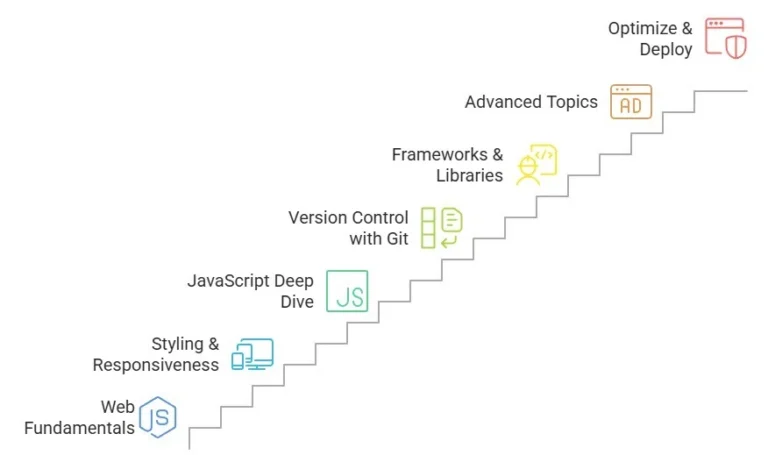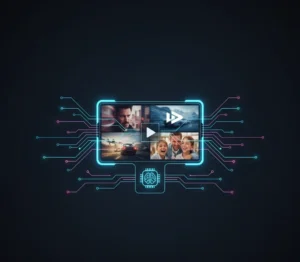Why the Frontend Developer Roadmap Matters in 2025
Imagine browsing a website that’s visually stunning, loads instantly, and feels effortless to navigate. That’s the magic of a skilled frontend developer at work. If you’re eager to craft user-friendly digital experiences, the frontend developer roadmap is your blueprint for success. In 2025, with web technologies evolving rapidly, mastering the right skills is key to launching a rewarding career. According to recent data, frontend developer roles have seen a 15% year-over-year increase in demand on platforms like LinkedIn.
Whether you’re wondering how to become a frontend developer or seeking to refine your frontend developer skills, this comprehensive roadmap will guide you. Let’s explore the frontend developer learning path to build a thriving career.
Table of Contents
What Does a Frontend Developer Do?
A frontend developer brings designs to life, creating the parts of websites or apps users see and interact with. Using HTML, CSS, JavaScript fundamentals, they build responsive, accessible, and interactive interfaces. Unlike backend developers, who focus on servers and databases, frontend developers prioritize client-side functionality and user experience.
For example, a frontend developer might optimize a site’s navigation to improve user retention, as seen in a case study where an e-commerce platform increased conversions by 20% through faster load times. Common questions like what does a frontend developer do? or what is the difference between frontend and backend developer? boil down to this: Frontend is about the visible, interactive layer; backend handles the hidden logic.
Essential Frontend Developer Skills for 2025
To excel, you need a blend of technical and soft skills. Here’s a breakdown of essential modern Frontend Developer Skills:
- HTML, CSS, JavaScript Fundamentals: The core trio. HTML structures content, CSS styles it, and JavaScript adds interactivity. Semantic HTML boosts SEO and accessibility in frontend development.
- Responsive Web Design Principles: With 58% of web traffic from mobile devices, fluid layouts using media queries and Grid are non-negotiable.
- Accessibility in Frontend Development: Follow WCAG guidelines (e.g., alt text, keyboard navigation) to ensure inclusivity.
- Frontend Frameworks and Libraries: React, Vue, or Angular streamline development. React holds a 40% market share in 2025.
- Version Control (Git): Essential for collaboration and code management.
- Performance Optimization: Techniques like lazy loading and code minification enhance speed.
- Soft Skills: Communication and problem-solving are critical for teamwork.
Current trends highlight AI-assisted coding, WebAssembly for performance, and eco-friendly coding practices. Stack Overflow’s 2024 survey shows 70% of developers use frameworks, underscoring their importance in the frontend development roadmap.
Step-by-Step Frontend Developer Learning Path

The Frontend Developer Roadmap is a structured journey. here’s how to become a frontend developer
Step 1: Master Web Fundamentals
- HTML: Learn tags, forms, and semantics. Build a static portfolio page.
- CSS: Master selectors, Flexbox, Grid. Style a responsive landing page.
- JavaScript: Study variables, DOM manipulation, events. Create a to-do list app.
Step 2: Advance Styling and Responsiveness
Learn responsive web design principles to make sites mobile-friendly. Practice media queries and test with tools like Chrome DevTools. Prioritize accessibility in frontend development by testing with screen readers like NVDA.
Step 3: Deepen JavaScript Knowledge
Master ES6+ features (promises, async/await) and API integration with Fetch or Axios.
Project: Build a weather app using a public API to practice real-world skills.
Step 4: Learn Version Control with Git
Tip: Contribute to open-source projects to gain experience.
Step 5: Master Frontend Frameworks and Libraries
How to learn frontend frameworks like React, Angular, or Vue? Start with React for its beginner-friendly ecosystem.
- React: Learn components, hooks, state. Build a single-page app.
- Vue/Angular: Explore for specific use cases like reactivity.
- Trend: Component libraries like Material-UI are popular for rapid prototyping in 2025.
Step 6: Tackle Advanced Topics
Study state management (Redux, Vuex), TypeScript, and testing (Jest). Explore Progressive Web Apps (PWAs) and Server-Side Rendering (Next.js).
Step 7: Optimize, Secure, and Deploy
Timeline: Expect 6-12 months for proficiency, depending on your pace.
Crafting Your Ultimate Frontend Developer Portfolio
A portfolio is your professional showcase, proving your frontend developer skills to employers and clients. It’s more than a collection of projects—it’s a story of your problem-solving, creativity, and technical expertise. In 2025, with hiring managers prioritizing practical skills, a well-crafted portfolio can boost callback rates by 30%, as seen in industry studies. How to build an exciting frontend developer portfolio? Follow these steps to create a standout portfolio that highlights your front-end skills and lands you interviews. For more tips, explore our portfolio-building guide.
Why a Portfolio Matters?
Your portfolio demonstrates real-world frontend developer skills, showing employers you can deliver. It’s your chance to highlight HTML, CSS, JavaScript fundamentals, responsiveness, and framework expertise. Unlike a resume, a portfolio provides tangible proof, making it easier to stand out in a competitive job market. A strong portfolio answers key employer questions:
- Can you code functional, user-friendly interfaces?
- Do you understand responsive web design principles?
- Can you solve problems creatively?
- Let’s dive into building a portfolio that shines.
Key Projects to Include
Include diverse projects to showcase versatility. Here are three essential types to feature:
1. Personal Website with HTML, CSS, JavaScript
Build a personal site from scratch using HTML, CSS, JavaScript fundamentals. This shows your core skills and creativity.
What to Include:
- A homepage with a professional bio.
- An “About” section highlighting your skills and passion.
- A projects page linking to your work.
- A contact form for inquiries.
Example: Create a portfolio site with a responsive navbar and animated hero section. Test accessibility with tools like WAVE.
2. Framework-Based Project (e.g., React Dashboard)
Showcase expertise in frontend frameworks and libraries with a project like a React dashboard.
What to Include:
- Dynamic data visualization (e.g., charts using Chart.js).
- State management (e.g., React hooks or Redux).
- API integration (e.g., fetching user data).
Example: Build a task management dashboard with React, featuring drag-and-drop functionality.
3. Responsive Redesign of an Existing Site
Redesign an existing website to demonstrate responsive web design principles and problem-solving.
What to Include:
- A before-and-after comparison.
- Mobile-first design with media queries.
- Accessibility features (e.g., ARIA roles, keyboard navigation).
Example: Redesign a restaurant’s outdated site, adding a mobile-friendly menu and faster load times.
Hosting Your Portfolio
Host your portfolio on GitHub Pages for free, reliable access. Alternatively, use or Vercel for modern deployment.
Steps:
- Push your code to a GitHub repository.
- Enable GitHub Pages in the repository settings.
- Use a custom domain (e.g., yourname.com) for professionalism.
FAQs
Can I become a frontend developer without a degree?
Yes, self-learning and bootcamps are viable paths.
How long does it take to learn frontend development?
6-12 months with consistent effort.
How to start a career as a frontend developer?
Learn fundamentals, build projects, network on LinkedIn.
What does a frontend developer do?
They build and maintain the user interface, ensuring interactivity and visuals align with designs.
What skills are required for frontend development?
Core: HTML/CSS/JS and Advanced: Frameworks, accessibility, responsive design.
How to master HTML, CSS, and JavaScript for frontend development?
Practice daily with real projects, use tutorials and challenges.
Is it possible to learn frontend development in 2 months?
Basics yes, but mastery takes longer; focus on consistent practice.
Conclusion: Start Your Frontend Developer Journey Today
The frontend developer roadmap is your guide to crafting user experiences that shine. From HTML, CSS, JavaScript fundamentals to mastering frontend frameworks and libraries, this path offers clear steps to success. Is it possible to learn frontend development in 2 months? You can grasp basics, but mastery requires dedication. Start small—code a project today.
Your career as a frontend developer awaits. Let’s build the future of the web together!


















